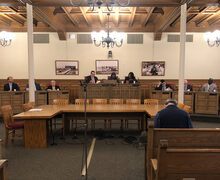Throwing around government money won’t rebuild central New York’s economy
Paul Schlesinger | Assistant Photo Editor
Cafe Kubal was awarded a CNYREDC grant to turn this Townsend street building into its new roastery.
If you invest $114 million in projects to jumpstart the economy, you’d want something to come out of them. But the Central New York Regional Economic Development Council has spent that much and created far fewer jobs than you’d expect.
The investments come in the form of Empire State Development Grants, which support everything from for-profit coffee shops to nonprofits with the goal of completing initiatives that are expected to boost the economy. But despite consistently investing in key industries, central New York’s economy has yet to compete effectively on a global scale. And unless the CNYREDC is more careful with its investments, it’ll only make the problem worse.
In six years, these Empire State Development projects have created 1,448 jobs and retained 1,445 at-risk jobs, according to the CNYREDC’s 2017-18 annual report. That’s only about half of the 2,651 jobs they were expected to generate.
The council also advertises an 11.1:1 average return on investment from the ESD projects. But it has an interesting method for calculating that ROI.
It’s found by comparing the total project cost to the total state funding given to the projects, said Jason Conwall, senior communications director for the ESD, in an email. Therefore, the 11.1:1 ratio represents total project cost to total state funding. Conwall said these projects are performance-based, and the funds are not disbursed to organizations until they meet the conditions of receiving that investment.
The ESD declined a request to further clarify this calculation and the ESD’s goals.
Traditionally, ROI is a measure of the efficiency of a particular investment. It’s calculated by subtracting the investment’s costs from its gains and then dividing by the costs. In this case, the state is calculating its ROI by comparing the amount the state has invested with the amount of private investment.
This has almost nothing to do with the efficiency of the investment. Under the state’s logic, an investment with an advertised 11:1 ROI could create zero jobs and have very little economic benefit.
And that’s what often happens, said Patrick Penfield, an assistant professor of supply chain management at Syracuse University. That’s why he’s against the government making these kinds of investments altogether.
“If I’m government and I give you some money to update your facilities and compete in industry, my expectation is that you’ll create so many jobs,” Penfield said.
Overall, the CNYREDC is investing too much money with little to show for it. But that doesn’t mean central New York should overlook business-boosting investments altogether. To minimize risk and maximize results, the council should be more selective when choosing where it invests.
For example, one of the largest funding requests came from Currier Plastics, which provides molding solutions for customers in the food, beverage, health and beauty markets. The company has requested $1,800,000 in funding to continue its expansion into the medical market, according to the CNYREDC’s 2017-18 progress report.
Although Penfield doesn’t believe the government should make these kinds of investments, he does consider the move a solid business decision.
“It’s always good to be in the medical field, because once you’re in, it’s very difficult to replace you as a supplier,” Penfield said. “It’s also very lucrative. You can get more money for products you sell.”
In 2015, New York state’s health care industry employed more than 1.2 million people, per a report from the Division of Research and Statistics. It’s profitable to be a supplier for the medical market, making this a smart investment for the CNYREDC.
One of this round’s CNYREDC proposals hits especially close to home. Like many buildings in downtown Syracuse, 321 and 323 S. Salina St. are vacant and run down. The proposal requests $320,000 to develop two mixed-use buildings with commercial and residential tenants.
As downtown Syracuse expands, there will be an increased demand for housing and commercial space. This project could help fill the gap in both scenarios. The project will create 20 jobs and 48 construction jobs, but the potential employment created from attracting businesses could be even greater.
These initiatives show promise, but New York needs to radically rethink how it will stimulate industry growth. That may mean loosening unnecessary regulations and lowering taxes before the state continues to pump money into target industries. Because even if a company can whip up a promising proposal, that doesn’t mean it’ll return a government investment.
Daniel Strauss is a junior finance major and public communications minor. His column appears biweekly. He can be reached at dstrauss@syr.edu and followed on Twitter @_thestrauss_.
Published on November 8, 2017 at 11:10 pm





